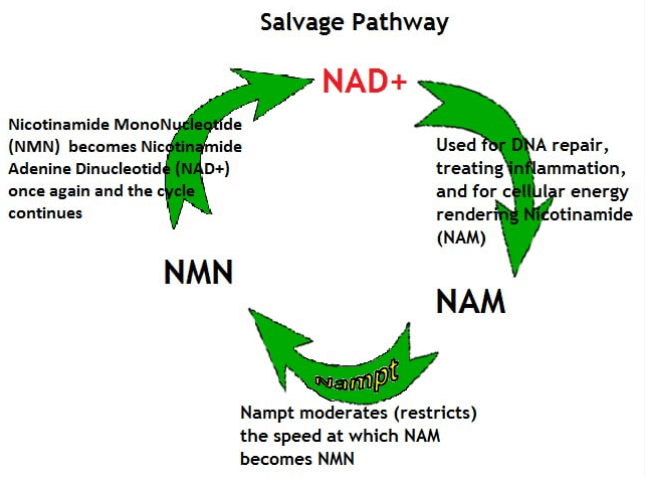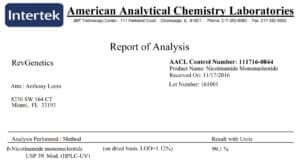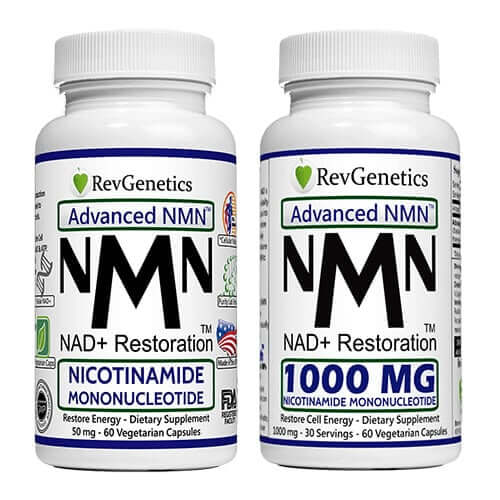Could Normal Dietary Source or NMN Food Reverse Aging?
Does an NMN Food Reverse Aging? We provide you with our studied opinion regarding the NMN Food (nicotinamide mononucleotide) in this copyrighted article and document. Please remember that we cannot provide medical advice or make medical claims on our products. We only make our products available for overall health. (Truly, Could An NMN Food Reverse Aging?)
Can I See The Mouse Nicotinamide Mononucleotide study?
The full NMN mouse study is now available to read at Pubmed.
Study Abstract: SIRT2 induces the checkpoint kinase BubR1 to increase lifespan. Mice overexpressing the mitotic checkpoint kinase gene BubR1 live longer, whereas mice hypomorphic for BubR1 (BubR1(H/H)) live shorter and show signs of accelerated aging. As wild-type mice age, BubR1 levels decline in many tissues, a process that is proposed to underlie normal aging and age-related diseases. Understanding why BubR1 declines with age and how to slow this process is therefore of considerable interest. The sirtuins (SIRT1-7) are a family of NAD(+)-dependent deacetylases that can delay age-related diseases. Here, we show that the loss of BubR1 levels with age is due to a decline in NAD(+) and the ability of SIRT2 to maintain lysine-668 of BubR1 in a deacetylated state, which is counteracted by the acetyltransferase CBP. Overexpression of SIRT2 or treatment of mice with the NAD(+) precursor nicotinamide mononucleotide (NMN Food) increases BubR1 abundance in vivo. Overexpression of SIRT2 in BubR1(H/H) animals increases median lifespan, with a greater effect in male mice. Together, these data indicate that further exploration of the potential of SIRT2 and NAD(+) to delay diseases of aging in mammals is warranted.
[Section One]
NMN, a forerunner to good health and long life
By Dr. H Valenzuela Ph.D.
It is hard to believe that such an important molecule as NAD (Nicotinamide Adenine Dinucleotide) was discovered 110 years ago. Although a Nobel Laureate first pointed out in 1930 how widespread and important this compound is to all living creatures, it is only recently that scientist discovered how a decrease in NAD production contributes to the aging process. An international group of scientist from the National Institute of Aging, Universities from Denmark, Norway and the United States have written a comprehensive review on NAD, summarizing how NAD is generated and consumed, how this contributes to aging and very importantly how supplementing our diet with NAD (and its precursors such as an NMN Food) can slow the aging process (Trend in Molecular Medicine, 2017). To simplify the article for our readers, we highlight the review article in the form of questions about NAD and the NMN Food.
Why are NAD and its precursor, NMN, so important to living creatures?
All living organisms possess NAD, which is clearly important evidence that NAD is as fundamental to life as are DNA or proteins. But let's be specific, for starters, all chemical reactions that convert our food into energy require NAD. As if that was not enough NAD plays a role in the removal of old proteins and old organelles (in particular the mitochondria) to maintain properly functioning cells. NAD is also a critical molecule that can regulate DNA repair and cell death. More recently, scientists discovered that depletion of NAD and its precursors promotes the aging rate. This last observation has been demonstrated to hold true on living organisms spanning from yeast to mice, and human clinical trials are ongoing but showing a lot of promise.
Why take NMN Foods instead of NAD, given that NAD is the essential molecule used by all living creatures?
It is all about how our body absorbs these compounds. During the digestion of foods or NAD supplements, NAD is converted to NMN before being absorbed by the epithelial cells in our gut. This step can be skipped by consuming NMN, and absorption can occur faster without consuming or needing any additional energy or time going from NAD to NMN in the intestine. Once NMN is absorbed into our bloodstream and then into our cells, it is converted back to NAD and utilized by our cells to carry out their functions. An additional advantage of taking NMN over other precursors is that NMN is only a single step from becoming NAD. (For more details on the 3 pathways that make NAD and NMN, please reference review.)
How exactly could an NMN Food extend our health and our life?
There are many successful approaches that extend lifespan which has been investigated by researchers. These approaches collectively are referred to as the Hallmarks of Aging Here we will review how NAD and its precursors have been shown to affect most of these hallmarks of aging pathways affecting lifespan.
- DNA repair. Studies have shown that maintaining keeping your DNA integrity intact will lead to a longer life. NAD and its precursors have been shown to can increase DNA repair in cells. Cells that have been treated were less likely to have DNA damage when compared to cells that were not treated.
- Mitochondria. As we age our mitochondria, which are involved in producing the energy that makes our cells work get damaged. NAD precursors have been shown to promote the creation of new mitochondria that can replace our old mitochondria, but they can also increase the removal of damaged mitochondria in our cells.
- Stem cells. NAD precursors help maintain stem cells' youthfulness and ability to regenerate.
- Cell Senescence. NAD concentrations drop during senescence, and NAD supplementations help delay oxidative stress associated with metabolism and senescence.
- Nutrient sensing. NMN has been shown to increase the consumption of lipids, increasing energy expenditure and improve carb sensitivity. These pathways are linked to sirtuins family members, SIRT-1 and SIRT-3 and their roles in regulating energy expenditure and carb sensitivity.
- Cellular communication. NMN has been shown to reverse age-associated expression of genes involved with +Inflammageing. These pathways are again linked to sirtuins family members, SIRT-1 and SIRT-3, but this time with their role in regenerating neurite ganglia and delaying axon (nerve cells) degeneration.
Besides delaying aging are there any other benefits to taking NMN?
In humans supplementation of NAD or its precursors (i.e., NMN Food) has been shown to decrease the pathology of Alzheimer’s disease in human neuron and restore mitochondria function in ATM disease; in the blood stream, triglycerides and glucose decrease; and finally, in the muscles, mitochondria’s function also increases giving individuals more vigor. In short, many age-related diseases can be fixed. In animals, these compounds have also been shown to improve hearing and eye damage caused by increasing age.
Why take NMN Foods when it is found in food?
Precursors to NAD and NAD can all be found in the food that we eat, such as, eggs, fish, meat, diary, whole grains and in some vegetables. The problem is that the amounts of these precursors are very low. For example, foods “rich” with NMN are broccoli, avocado, and beef. Of these examples, avocado has the highest concentrations of NMN at 1.6 mg/100 g. However, to eat the equivalent of one of our 25 mg NMN pills, a person would need to eat 3.44 lbs. of avocado! As much as we like avocados, this would be difficult to accomplish on a daily basis.
[Section Two]
Want more information? Great! Below is our previous technical overview on nicotinamide mononucleotide:
Nicotinamide Mononucleotide - Can An NMN Food Reverse Aging, Truly?
Download Copyrighted PDF of This Document
The available scientific literature has clearly described a decline in the level of Co-enzyme Nicotinamide Adenine Dinucleotide (NAD+) in both murine (mice) and human studies. It is a direct function of the aging process as shown in multiple different studies. As the level of NAD+ decreases, the body starts to decline in numerous ways.
As an example, type II Diabetes (T2D) has the newest cases diagnosed between the ages of 45 to 64 as this decrease in NAD+ starts to manifest itself. This lower production is revealed elsewhere, particularly in the form of increased oxidative stress, +Inflammageing, poorer immune response, and lower lipid (fat) metabolism, which is why we tend to gain weight as we age. Supplementation with Nicotinamide Mononucleotide (NMN) has been shown to ameliorate all of these age-related conditions, including providing impressive hepatic (liver) sensitivity improvement.
NAD+ has been shown to be essential for supporting bodily functions by enhancing sensitivity, improving energy metabolism, and improving stress resistance. It also participates in genome protection through DNA repair, is neuroprotective, and is required for SIRTUIN activation.
SIRTUIN genes act as an anti-aging gene in yeast, and in murine studies one of the activators for the SIRTUIN SIT1 (signaling threshold regulating transmembrane adaptor 1) called resveratrol has been shown to activate mitochondrial biogenesis—and more mitochondria in the cells mean more available energy for the cell to function and conduct repairs.
In another murine study, age-related arterial dysfunction in older control (OC) mice versus young control (YC) mice showed that the OCs had impaired carotid artery function compared to YC at only 60% compared to 84%, respectively. Treating with NMN resulted in restoration to 86% in OC. There was also an improvement to the elasticity of the blood vessels (improved elastin), along with reduced stiffness (decreased collagen-1), lowered aortic pulse wave velocity, and decreased chemical markers (nitrotyrosine) for oxidative stress. The OCs essentially became YCs in all but age.
In a 2013 Harvard study, the Harvard scientists observed that “NMN was able to mitigate most age-related declines in mice,” and that “treatment of old mice with NMN reversed all of these biochemical aspects of aging.” The study concluded that “enhancing NAD+ biosynthesis by using NAD+ intermediates, such as NMN and NR (Nicotinamide Riboside), is expected to ameliorate age-associated physiological decline”.
This has precipitated dozens of studies since that are focused on investigating NMN Food to treat Cardiovascular disease, Diabetes, Obesity, life extension, Cancer, Alzheimer’s disease, Parkinson’s disease, and many more.
Regarding function, NAD+ operates in a way akin to resveratrol and other polyphenols but is considerably more effective (on the order of ~100 times). It can act on (disable/detach/destroy) the proteins that inappropriately connect to the histone proteins that form the latticework upon which the DNA winds itself. This appears to be a large factor in the aging process, and supplants antedated prior theories about mutations being the cause.
Imagine, if you will, a strand of DNA, appropriately folded and functioning perfectly. Suddenly gene modifying proteins start to spawn because there is insufficient NAD+ to scavenge the oxidative radicals.
To understand this, think of these nasty proteins as “on” switches. They latch onto the DNA molecule’s receptors; fortunately, most of them attach to DNA that has no specific function—what we call the “junk DNA”—but periodically they will attach to something important.
At this point, it overrides the internal instructions and turns on inappropriate functions. All DNA is coded to create all of the cells in the body upon need, but how useful would it be if a brain cell suddenly had instructions turned on that told it that it was now a liver cell?
NAD+ can detach these invasive and detrimental gene modifiers, allowing the over-active gene to return to its normal quiescent state, only turning back on when truly required. In proper concentrations, as in our youth, it can destroy these proteins before they can do any damage at all. If the gene modifiers have already invaded, research shows that it can stop the effect being expressed in and on the DNA. Better yet, it appears to arrest the progress of the disease state, allowing DNA to reverse itself to a normally healthy condition.
That being said, NAD+ is far too big a molecule to be able to penetrate a cell wall. It can neither access the DNA nor enhance the effect of the mitochondria (by making energy more available) in its final form. While these are primary functions for NAD+, NAD+ genesis needs to take place within cells.
Taking NAD+ as a supplement will do absolutely nothing for your health. It will pass through or be digested, resulting in slightly more expensive urine, but very little else. However, the much smaller precursor molecules (such as NMN and NR), can easily penetrate the micro-pores for chemical exchange in cell walls. So, as long as the mechanism for making NAD+ is intact inside the cells, the body can make all the NAD+ it requires.
This occurs primarily through two distinct metabolic pathways in our bodies, including either the Tryptophan or the Nicotinic Acid (the B-vitamin Niacin) derived de novo pathways, and/or the nicotinamide, nicotinic acid, and/or nucleoside salvage pathways, incorporating both nicotinamide riboside and nicotinic acid riboside.
The first one, the De Novo pathway, gets its name from the Latin meaning “from scratch” or “from the beginning”. Nucleotides are derived from constituent precursors such as tryptophan, which we’ve mentioned previously. It is responsible for about 15% of our NAD+ production throughout our lives.

The second path is called the Salvage pathway. It quite literally salvages nucleosides and bases whenever DNA and RNA are broken down; it also makes up a part of the body’s ongoing energy generation process.
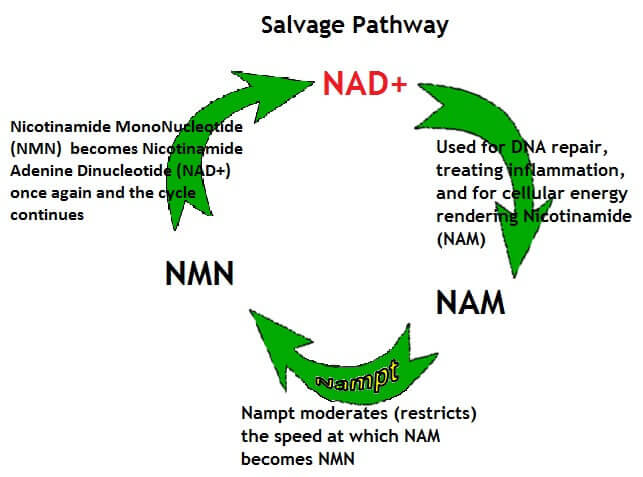
The Salvage pathway is responsible for the remaining 85% of our NAD+ requirements. There is a problem with this pathway, however, because of a rate-limiting enzyme named Nicotinamide phosphoribosyltransferase, aka NAmPRTase or Nampt.
Nampt is like an over-ambitious traffic cop, working a multi-lane four-way intersection with broken traffic lights, which only allows one car to pass at a time, and the next one can’t start moving until the first one completely clears the intersection. It slows down everyone, creating more problems than it solves.
Once NAD+ is “used” it becomes NAM (Nicotinamide), but because of the Nampt restriction, it requires a full 8 hours to return to peak NAD+ levels. Like NAM, Nicotinamide Riboside (NR) is processed through the Salvage pathway, and takes just as long, 8 hours, to reach peak levels.
In contrast, NMN completely bypasses the Nampt bottleneck and can reach peak levels in just 30 minutes. Clearly, this is a significant advantage particularly as we age and our ability to produce NAD+ diminishes.
Consider that between ages 0-10 we produce up to 300% more NAD+ than we need since our bodies are growing quickly. As we approach age 45, the production has decreased to about 100% of our needs. Beyond that, and for the rest of our lives, the NAD+ production drops below our bodies’
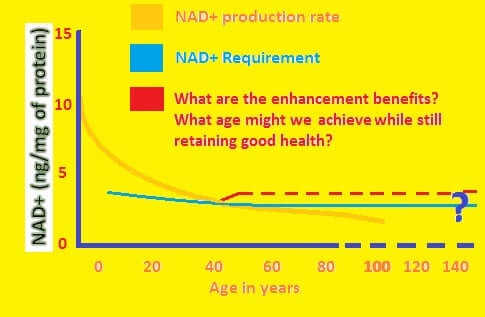
requirements after which deterioration sets in and our systems begin to fail. Until we die, we are always short by about 20% of our actual needs after age 50.
By providing adequate precursors to the NAD+ formation, we can bypass the restricted or compromised Scavenger pathways and instead take advantage of the underutilized De Novo pathway. Even if that doesn't result in life extension (though it should), a normal lifespan will likely be much more enjoyable and free of the debilitating disease usually associated with age. But without NAD+ and AMP (Adenosine Mono-Phosphate) in sufficient quantity, all of this rebuilding and maintenance comes to a grinding halt, and we age.
In the liver, the preferred substrate for NAD+ building has always been tryptophan which provides the highest concentrations of this essential co-enzyme. It is important to note that NAD+ is the key to communicating between the cell nucleus, ultimately driving cell activity, and the mitochondria which provide the energy required by the cell.
What Works
It is interesting to note that some things work better than others, which only makes sense.
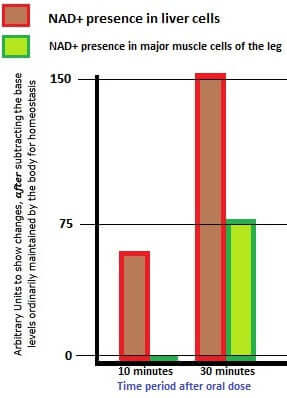
- NAM is plentiful and can enter cells with relative ease but is dependent on Nampt for conversion into a useful NAD+ molecule
- NR taken orally is largely ineffective. It is digested and becomes NAM, thereby limiting its efficacy. Introduced directly into the bloodstream it bypasses the Nampt restricting enzyme, but unless using an I.V. drip, you would need to be constantly injecting nicotinamide to make it effective
- NMN Food taken orally quickly elevates the NMN levels in the bloodstream and maintains the elevated levels much longer than NAM, NA, or NR.
In this chart, you can see that the oral dose was effective in as little as 10 minutes in the liver. After 30 minutes had elapsed, not only had it more than doubled the



